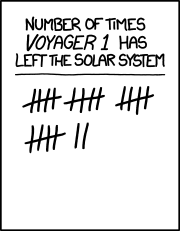By Tushna Commissariat
It’s a running joke at the Physics World news desk – the exact location of the Voyager 1 probe and how often we end up writing about how it really has nearly left the solar system this time. So we decided to wait and watch when the news broke on Wednesday evening this week that the probe had left the solar system for sure (again).
Unsurprisingly, the next morning our inboxes included a slightly sheepish “status update” message from NASA. “The Voyager team is aware of reports today that NASA’s Voyager 1 has left the solar system,” says Edward Stone, Voyager project scientist based at the California Institute of Technology, Pasadena. “It is the consensus of the Voyager science team that Voyager 1 has not yet left the solar system or reached interstellar space. In December 2012 the Voyager science team reported that Voyager 1 is within a new region called ‘the magnetic highway’ where energetic particles changed dramatically. A change in the direction of the magnetic field is the last critical indicator of reaching interstellar space, and that change of direction has not yet been observed.”
This morning I came across the latest xkcd webcomic (above), wherein former-physicist-turned-comic-artist Randall Munroe perfectly encapsulates the Voyager 1 location conundrum. The rollover text for the comic strip reads “So far Voyager 1 has ‘left the solar system’ by passing through the termination shock three times, the heliopause twice, and once each through the heliosheath, heliosphere, heliodrome, auroral discontinuity, Heaviside layer, trans-Neptunian panic zone, magnetogap, US Census Bureau Solar System statistical boundary, Kuiper gauntlet, Oort void and crystal sphere holding the fixed stars.” I couldn’t help but laugh!

Do they still receive the signals from the Voyager-1? If they do, they should reasonbly know its speed and location in real time. If these signals are not there anymore, then, well, good luck for its spatial voyage.
They still receive signals from Voyager-1. But they can’t know its speed and location in real time because of the fact that distance is large and signal travels at speed of light and takes some enough time to reach the Earth. So no real time.
I don’t get the confusion.
As far as i’m know its now where near out the solar system , the solar system ends where the gravitational influence ends.
and thats like 1000+ (10000+?) years in the future.
@Ashgar — Both Voyager 1 and 2 are returning good data, including cosmic ray fluences and magnetic field measurements. Their RTG power systems are likely to operate for a few more years at best.
@Skamp_X — The “confusion” is simple, if you understand the physics. Defining the “edge of the solar system” is rather like defining the “edge of the atmosphere.” Since the system involves a smoothly varying density (for the atmosphere, the amount of gas relative to interplanetary space; for the solar system, issues like the magnetic field and flux of solar-derived charged particles) there is no well-defined “boundary.” The solar system ends where its _influence_ ends, which is a region, not a point.
Michael, what is the width of the “edge of the solar region” for the transition to outer space?
Interesting
two artist working with and exiting approach to the voyager
http://fromtheislandproject.blogspot.co.uk/
Trackback: Blog - physicsworld.com